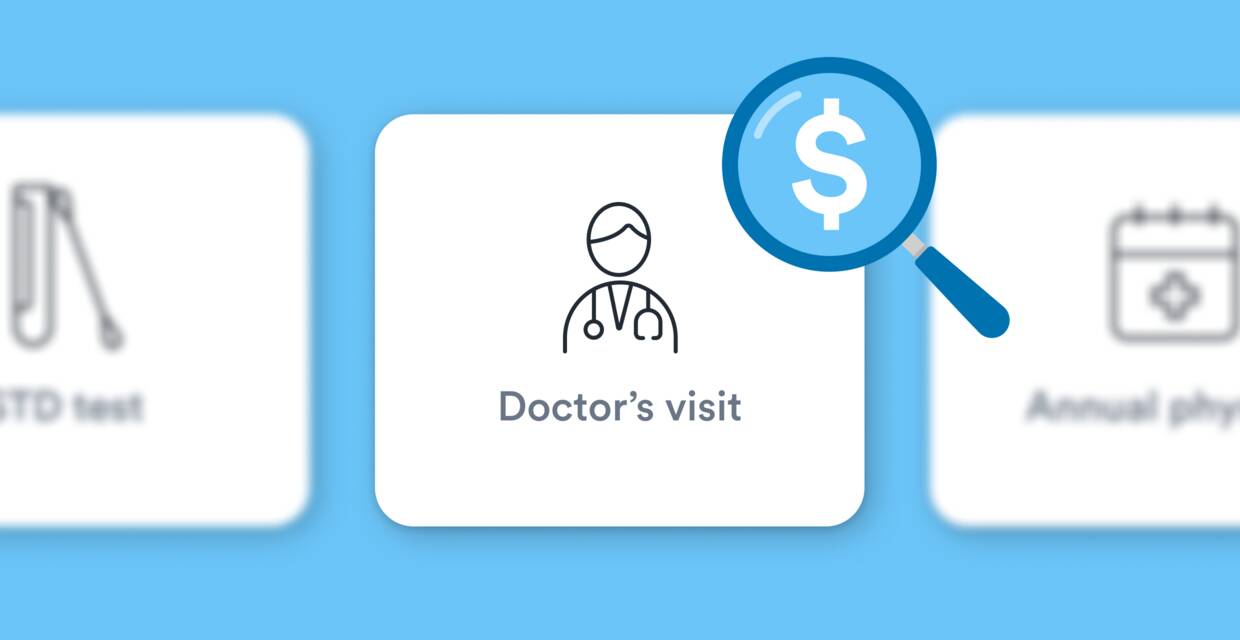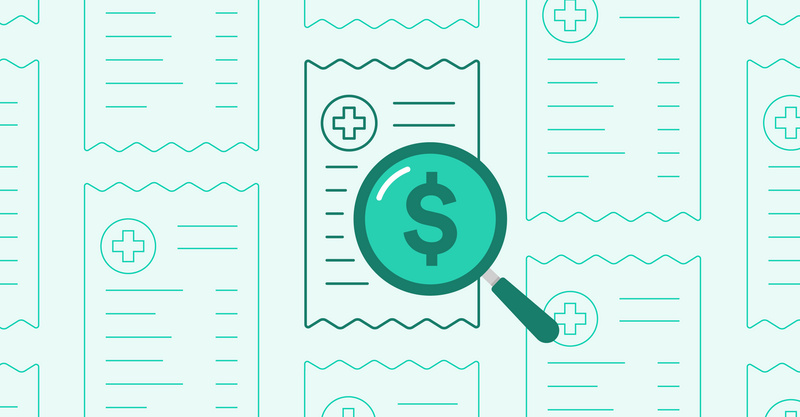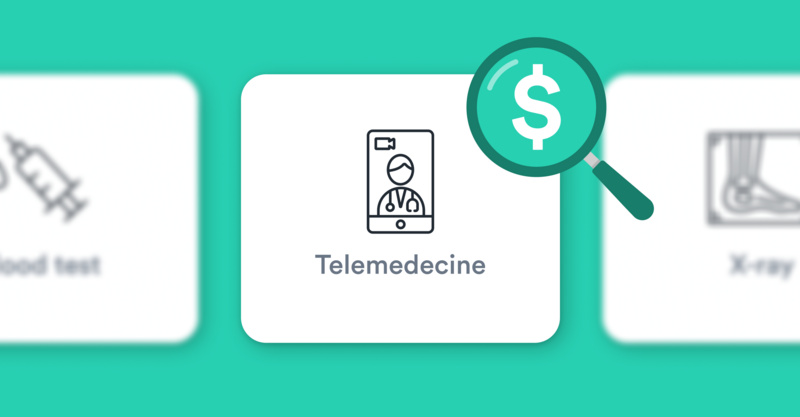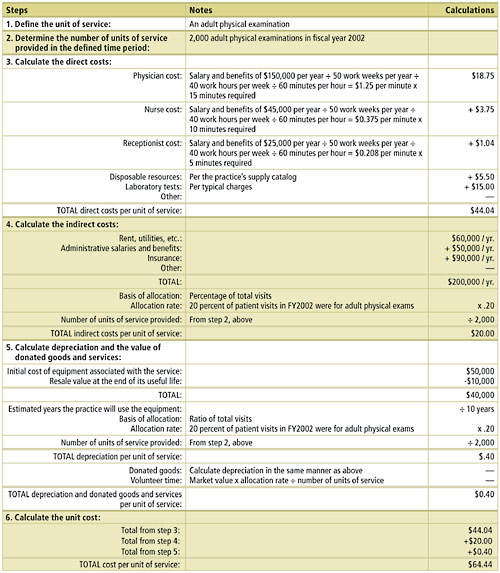How Much Does a Doctor Visit Cost With and Without Insurance?
Without insurance, medical care can get pricy fast. Where you live, what doctor you’re going to, and what tests you need will all figure into your doctor’s visit bill. In this article, we’ll break down those costs and give you some tips for saving money.

What Goes into the Cost of a Doctor’s Visit?
Geography is one of the biggest factors in the price of a doctor’s visit. Most medical facilities pass some of their overhead expenses onto their patients. If you live somewhere with a higher cost of living, like California or New York City, you’ll likely pay more for doctors’ visits. The practice has to pay more for utilities and rent, and those costs show up in your bill. For example, Mayo Clinic’s Patient Estimates tool quotes $846 for a 60-minute office visit in Jacksonville, Florida, but $605 for the same visit in Wisconsin.
Like the cost of living, supplies and equipment will also end up on your tab. Say you need a strep test, blood draw, or Pap smear. The supplies needed for the test plus the cost of the lab fees will all figure into the price.
Bills for the same exams and procedures can also vary depending on what kind of facility you’re going to. Smaller practices and public health centers are often a lot cheaper than university or private hospital systems. This is due in part to their buildings being smaller and their overhead fees being lower.
Price of Out-of-Pocket Doctors’ Visits
The cost of a doctor’s office visit also depends on what kind of doctor and the procedure you need to have done. For example, an in-office general wellness checkup will be cheaper than a specialist procedure. If you have an emergency, an urgent care center will be much more affordable than the emergency room.
Primary Care Physician — Physical Exam
Physicals usually include blood pressure readings, cholesterol measurements, and vaccines. Prostate exams for men and Pap smears and breast exams for women are also often included. Pediatric physicals focus on the growth milestones for your child’s age. Doctors check height, weight, sleep patterns, diet, and the vaccines required by public schools.
The range for a yearly physical can be anywhere from $100 to $250 or more without insurance. A CVS Minutecare Clinic may charge just $59 for a sports physical, but not all organizations will accept this as proof of physical health.
Primary Care Physician — Procedures
On top of the base cost for physical exams, you may have extra charges for any specific tests or procedures you need. According to the Cardiometabolic Health blog, the most common procedures in primary care medicine include bloodwork, electrocardiograms, and vaccines/injections.
Bloodwork is one of the biggest cost wild cards. Certain tests can run you from as little as $10 to as much as $10,000 . Large national labs like Labcorp offer pricing on their website, so you know what to expect going in. For example, Labcorp’s General Health Blood Test , which includes a metabolic panel, complete blood count (CBC), and urinalysis, costs $78.
Electrocardiograms or EKGs check your heart health and can find cardi ac issues. This quick procedure involves monitoring your heartbeat through electrodes placed on your skin. While it’s a painless and accurate way to detect heart conditions, the costs can add up without insurance. Expect to pay as little as $410 or as much as $1700 for this procedure, depending on local prices.
Vaccines are often required before sending your kids to school. The CDC publishes a vaccination price list annually to give you an idea of what to expect. For example, they quote $19-$132 for DTaP, $21 for Hepatitis A, and $13-$65 for Hepatitis B. The COVID-19 vaccine, however, is free of cost, regardless of insurance status.
Urgent Care Visit
If you have an emergency but are stable, urgent care is much cheaper than the emergency room. According to Scripps , most urgent care centers and walk-in clinics can at least treat dehydration, cuts or simple fractures, fever, flu, strep, and UTIs. Note that if you have chest pain, a serious injury, seizures, a stroke, or pregnancy complications, you should go straight to the ER .
For a base exam at an urgent care facility, expect to pay between $100-$150 . That price will go up depending on what else you need. For example, Advanced Urgent Care in Denver quotes $80 for an X-Ray, $50 for an EKG, $135 for stitches, and $5 for a urinalysis. In comparison, expect to pay $1,000-$1,300 for the same procedures in the emergency room.
How to Lower Your Out-of-Pocket Medical Costs

Healthcare expenses may seem overwhelming without insurance. Luckily, there are many resources available to help you cover the costs.
Free & Low-Cost Immunization and Wellness Clinics
For standard vaccines and checkups, look for local free or low-cost clinics. Check out The National Association of Free and Charitable Clinics’ search tool to find a location near you. Your city’s public health department should also offer free or low-cost vaccines and basic medical care services.
Certain large vaccine manufacturers also offer vaccine programs. For example, Merck’s patient assistance program offers 37 vaccines and medicines free to eligible patients. The program includes albuterol inhalers and vaccines for Hepatitis A, Hepatitis B, MMR, and HPV.
Cash Negotiations
Most health systems offer lower rates for patients paying cash. Some even have free programs for low-income families. For example, Heritage UPC in North Carolina has a yearly membership for low-cost preventative care. In Northern California, the Sutter Health medical system offers full coverage for patients earning 400% or less of the Federal Poverty Income Guideline .
As of January 1, 2021, all hospitals in the United States now have to follow the Hospital Price Transparency Rule . That means they have to list procedure prices clearly on their website. You can also call medical billing before your appointment to discuss cash pay options.
Federal Medical Payment Support
If all else fails, there are federal programs to help you cover the cost of medical bills.
Organizations like The United Way and United for Alice offer grants for ALICE (asset-limited, income-constrained, employed) patients. These are people living above the poverty level, making them ineligible for other government programs but below the basic cost-of-living threshold.
Medicaid is available for children, pregnant women, and adults under a certain income threshold. If your income is too high to qualify for Medicaid but you can’t afford private insurance for your children, you may be eligible for the Children’s Health Insurance Program (CHIP) to cover your children’s medical care.
Use Compare.com for the Best Doctors’ Visit Prices
Navigating bills for a doctor’s visit can feel overwhelming, but Compare.com is here to help. With our price comparison tool, you can search all clinic and doctors’ office prices in your area. Compare makes sure you’re prepared for the cost of your checkup long before you schedule your appointment.

Nick Versaw leads Compare.com's editorial department, where he and his team specialize in crafting helpful, easy-to-understand content about car insurance and other related topics. With nearly a decade of experience writing and editing insurance and personal finance articles, his work has helped readers discover substantial savings on necessary expenses, including insurance, transportation, health care, and more.
As an award-winning writer, Nick has seen his work published in countless renowned publications, such as the Washington Post, Los Angeles Times, and U.S. News & World Report. He graduated with Latin honors from Virginia Commonwealth University, where he earned his Bachelor's Degree in Digital Journalism.
Compare Car Insurance Quotes
Get free car insurance quotes, recent articles.

Find Urgent Care today
Find and book appointments for:.
- Urgent Care
- Pediatric Urgent Care
- COVID Testing
- COVID Vaccine
How Much Does a Doctor’s Visit Cost Without Insurance?

According to the Agency for Healthcare Research and Quality, the average cost of a visit to the doctor’s office in 2016 was $265, with expenses ranging from $159 to $419 depending on the specialty.
- At an urgent care center you can expect to pay between $100-200 to see a provider, plus the cost of any treatments or testing you may need.
- Always ask for pricing information before you agree to any testing or treatment. You are entitled to this information.
Going to the doctor for any reason can be expensive. Without insurance, you can expect to pay approximately anywhere from $50–$350 just for a routine medical exam, which doesn’t include additional expenses such as x-rays , blood tests, or other lab work.

The cost of a doctor's visit
According to Solv’s Chief Medical Officer, Dr. Rob Rohatsch, the cost of a doctor’s visit can vary widely depending on factors such as:
- The type of doctor you are seeing
- The reason for your visit
- Where you see the doctor, for example, if you go to an urgent care facility or a doctor’s office
- Whether you are a new or established patient
- Any necessary tests or treatments
- Whether you need lab work
Visits to specialists such as primary care providers, pediatricians, and psychiatrists were lower than the average cost, while the most expensive doctor’s visits were for orthopedists and cardiologists.
Data from the Agency for Healthcare Research and Quality indicates that if you are visiting a doctor and don’t have insurance, you can expect to pay roughly the following amounts. The cost could vary depending on the factors listed above.
- Psychiatry: $159
- Pediatrics: $169
- Primary care: $186
- Dermatology: $268
- OB/GYN: $280
- Ophthalmology: $307
- Cardiology: $335
- All other: $365
- Orthopedics: $419
Additionally, if you are a new patient, there may be an additional charge associated with your new patient exam.
Where to see a doctor without insurance
If you don’t have insurance, the cost of your doctor’s visit can also be affected by where you go to see the doctor. There are many places you can seek medical care, some of which are more affordable than others, notes the Agency for Healthcare Research and Quality:
- Community health clinics often provide free medical care or low-cost care, including preventive care, health screenings, and vaccinations .
- Urgent care centers offer many health services. Many don’t require appointments, although your wait time may be less if you schedule an appointment in advance. You can expect to pay around $100 - $200 to see an urgent care provider, plus the cost of any treatments or testing you may need.
- Many health care facilities now offer telehealth services, which are often more convenient and more affordable. For some conditions, however, you may need to be seen in person for proper diagnosis and treatment.
- If your medical need is not urgent, and you know the type of doctor you need to see, you can schedule an appointment with a primary care physician or a specialist at their office. Be sure to ask about their payment policy in advance. If you don’t have insurance, you may be required to pay the entire bill at the time of service.
- If you have a medical emergency, you can visit the nearest emergency room. Even if you don’t have insurance, you will be able to receive treatment. However, this is typically the most expensive option. If you have a non-emergency medical condition that can wait until you can be seen at one of the other options, you will likely save money.
Paying self-pay prices for doctor’s visits
Even if you have insurance, you may be able to save money by paying cash for certain medical services. While preventive care may be covered at 100% by your insurance company, other tests and treatments may be applied to your deductible. If you have a high deductible and don’t expect to meet it – especially if it’s late in the calendar year – paying cash for your medical care may be a cheaper option.
Most doctor’s offices and health care providers charge a higher price when they bill the insurance company. For example, they may charge the insurance company $70 for a treatment or service, but if the patient is paying cash, they may only charge $60. This is known as the self-pay price . If you pay cash, the claim won’t be submitted to your insurance company, but you could end up saving money.
Always ask for pricing information before you agree to any testing or treatment. You are entitled to this information. As of 2021, hospitals are required to disclose self-pay prices, even when the patient has insurance. If the doctor’s office won’t provide you with this information, be persistent, or seek care somewhere else. If you plan on paying self-care prices, you aren’t limited to the providers in your insurance network. You’ll have a wider range of options to choose from, and you can choose a provider who is willing to provide fair, clear prices.
Let your doctor’s office know that you are paying out of pocket, and ask if they offer a discount for self-pay patients. Many doctor’s offices will offer special rates for patients who are paying cash or who do not have insurance; however, they may not advertise these rates, so it’s always a good idea to ask.
Know what you’ll pay ahead of time with Solv ClearPrice TM
According to Healthcare Finance News, more than half of Americans avoid going to the doctor when they’re sick due to high medical costs or unclear costs. Solv is committed to eliminating surprise medical bills with Solv ClearPrice™ . We partner with thousands of providers across the country who have agreed to display self-pay prices for their services. When you book an appointment on Solv, you will be able to see the self-pay price for many common services.
To schedule an appointment, search our directory for a provider in your area. Begin typing the service you are looking for, and choose from the list of options that appear. If you aren’t sure which type of doctor you need to see, you may want to try an urgent care clinic or a walk-in clinic . In many cases, you can schedule an appointment quickly and conveniently online, and many of our providers have same-day or next-day appointments available.
Frequently asked questions
What factors affect the cost of a doctor's visit, what is the average cost of a visit to the doctor’s office, are there any additional charges for new patients, where can i seek medical care if i don't have insurance, what is the self-pay price, are hospitals required to disclose self-pay prices, can i get a discount if i'm paying out of pocket, what is solv clearprice™.
Michael is an experienced healthcare marketer, husband and father of three. He has worked alongside healthcare leaders at Johns Hopkins, Cleveland Clinic, St. Luke's, Baylor Scott and White, HCA, and many more, and currently leads strategic growth at Solv.

Dr. Rob Rohatsch leverages his vast experience in ambulatory medicine, on-demand healthcare, and consumerism to spearhead strategic initiatives. With expertise in operations, revenue cycle management, and clinical practices, he also contributes his knowledge to the academic world, having served in the US Air Force and earned an MD from Jefferson Medical College. Presently, he is part of the faculty at the University of Tennessee's Haslam School of Business, teaching in the Executive MBA Program, and holds positions on various boards, including chairing The TJ Lobraico Foundation.
Solv has strict sourcing guidelines and relies on peer-reviewed studies, academic research institutions, and medical associations. We avoid using tertiary references.
- Agency for Healthcare Research and Quality: Expenses for Office-Based Physician Visits by Specialty and Insurance Type, 2016 https://meps.ahrq.gov/data_files/publications/st517/stat517.shtml
- Hospital Price Transparency, Centers for Medicare and Medicaid (2022) https://www.cms.gov/hospital-price-transparency
- More than half of Americans have avoided medical care due to cost (2019) https://www.healthcarefinancenews.com/news/more-half-americans-have-avoided-medical-care-due-cost
- telemedicine
- primary care
- healthcare costs
- health insurance
- urgent care

Quality healthcare is just a click away with the Solv App
Book same-day care for you and your family
Find top providers near you
Choose in-person or video visits, manage visits on-the-go, related articles.

How Much Do Annual Physicals Cost Without Insurance?
If you are in need of an annual physical, you may be wondering how much annual physicals cost without insurance....

What is Price Transparency? A consumer’s guide to healthcare costs
No one likes receiving a surprise medical bill, especially when the cost wasn’t clear at the time you needed...

Cost of Blood Test Without Insurance in 2022
When you don’t have health insurance, you’re likely to keep a closer eye on all of your medical costs....

Real-Life Surprise Medical Bills: Six Different Bills for Knee Surgery
As part of Solv’s ClearPriceTM initiative, our team is highlighting real-life stories about how surprise...

How Much Do Stitches Cost Without Insurance?
You fell and got a nasty gash that’s going to require stitches. You can easily get it fixed at an urgent care...

How to Save Money on Healthcare Through Self-Pay
Americans hold a few core beliefs about how health insurance is supposed to work. They know that it’s meant to...

How Much Does Telemedicine Cost Without Insurance?
During the COVID-19 pandemic, when most of the world was quarantined in the confines of their own homes, the use...

Guide to Navigating an Urgent Care Visit Without Insurance
It’s no secret that more and more Americans are taking on health plans with outrageously high deductibles or...

Discounts at the Doctor’s Office?
The healthcare system can be complicated. It often feels overwhelming. Between headlines and legislation,...

Real-Life Surprise Medical Bills: The $6,000 Emergency Room Bill
Related health concerns.
Abdominal Pain
COVID-19 Vaccine
Cataract Surgery
Cold Medicine
Daycare Physical
Pinched Nerve
Sexually Transmitted Diseases
Urinary Tract Infection (UTI)
Urine Culture
This site uses cookies to provide you with a great user experience. By using Solv, you accept our use of cookies.
Cost of doctor visit by state
The following estimated costs are based on cash prices that providers have historically charged on average for doctor visit and will vary depending on where the service is done. The prices do not include the anesthesia, imaging, and other doctor visit fees that normally accompany doctor visit.
Need help to cover that price?
See how Sidecar Health insurance can help cover your medical needs.
What happens at a doctor's visit?
People go to the doctor for routine physical exams as well as acute care when they get sick or injured. Visits to the doctor are important for preventing disease and managing any health problems. During your doctor’s visit, the physician checks your blood pressure, temperature, and heart rate.
Your doctor may listen to your heart, check your ears, nose, and mouth, and perform a physical exam. They may also ask you about your medical history and the medications you take. Your doctor may want you to have blood drawn for laboratory testing during your doctor’s visit.
How long should a doctor’s visit last?
It’s common for your entire visit to the doctor to take a long time. From start to finish, your appointment may take well over an hour . Many patients sit in the waiting room before being called back for examination.
How long you’ll wait depends on your specific doctor’s office and how busy they are. Once you’re in the exam room, the visit with your doctor will go quickly. On average, patients spend about 20 minutes in the exam room with their doctor.
Why are doctor visits so expensive?
Doctor's visits are expensive for several reasons, including their offices’ administrative responsibilities and the cost of medical services. Your doctor’s office has to work with different insurance companies and pay administrative staff trained in medical billing. Your doctor charges for their services, lab work, or imaging they run and may charge facility fees as well.
How much does a doctor visit cost without insurance?
Without insurance, your doctor’s visit can cost hundreds of dollars. On average, people in the U.S. pay just under $400 for their annual physical exam at a doctor’s office if they don’t have insurance. These costs include the provider fee for seeing the doctor and costs for any blood work or imaging that’s needed.
What are the signs of a bad doctor?
Know the warning signs of a bad doctor so you can avoid problems and get better medical care. One sign is if your doctor doesn’t listen to you or take your concerns into account during your visit. Another is if your doctor rushes through your appointment, not giving you the time needed to deal with your concerns.
A third warning sign is if your doctor doesn’t explain why certain tests or treatments are needed in a way you can understand.
What should you not tell your doctor?
Your doctor doesn’t need to know every detail about your life to provide proper care. But they do need you to be truthful about your health. You should never lie about the symptoms you’re experiencing or the medications you’re taking. If you aren’t taking medications as prescribed, your doctor needs to know. You don’t need to tell them health details they already know or give them any of your financial information.
Costs vary by specialty
The cost of a doctor visit could vary depending on the specialty. To see the cash prices for a specialist visit, type is a specialty.
* Savings estimate based on a study of more than 1 billion claims comparing self-pay (or cash pay) prices of a frequency-weighted market basket of procedures to insurer-negotiated rates for the same. Claims were collected between July 2017 and July 2019. R.Lawrence Van Horn, Arthur Laffer, Robert L.Metcalf. 2019. The Transformative Potential for Price Transparency in Healthcare: Benefits for Consumers and Providers. Health Management Policy and Innovation, Volume 4, Issue 3.
Sidecar Health offers and administers a variety of plans including ACA compliant and excepted benefit plans. Coverage and plan options may vary or may not be available in all states.
Your actual costs may be higher or lower than these cost estimates. Check with your provider and health plan details to confirm the costs that you may be charged for a service or procedure.You are responsible for costs that are not covered and for getting any pre-authorizations or referrals required by your health plan. Neither payments nor benefits are guaranteed. Provider data, including price data, provided in part by Turquoise Health.
The site is not a substitute for medical or healthcare advice and does not serve as a recommendation for a particular provider or type of medical or healthcare.
Health Spending
- Quality of Care
Access & Affordability
- Health & Wellbeing
- Price Transparency
- Affordability
- Prescription Drugs
How costly are common health services in the United States?
By Daniel McDermott , Julie Hudman , Dustin Cotliar, Gary Claxton , Cynthia Cox Twitter , and Matthew Rae Twitter
November 4, 2020
Stay Connected
Get the best of the Health System Tracker delivered to your inbox.
It is well documented that the U.S. is an outlier among peer countries when it comes to health spending, and recent Peterson-KFF analysis finds that the cost of inpatient and outpatient care is the primary driver behind this gap in health expenditures. In addition, countless news articles have highlighted extremely high medical bills sent to patients, often resulting from balance billing from out-of-network providers. However, the actual costs of specific healthcare services in the U.S. are often hard to track down and can vary widely between plans and across the country.
In this analysis, we explore the average cost of several common healthcare services in the U.S. We analyzed data from a sample of the IBM MarketScan Commercial Claims and Encounters Database, which includes health claims from non-elderly people enrolled in large employer plans. When possible, we show how these costs have changed over time and how they vary geographically.
The charts in this analysis show average allowed amounts large employer health plans agree to pay for in-network and out-of-network care. We refer to “cost” as the weighted average total expenditures made towards a given admission or service, including the portion paid by the health plan and any out-of-pocket costs paid by enrollees under the plan’s cost sharing. However, the charts do not include any balance bills (“surprise bills”) that out-of-network providers may send directly to patients.
This collection demonstrates that the costs associated with many common health services have risen more rapidly than general economic inflation, and that there are large geographic variations in the cost of the same health services across the United States. For example:
- The average cost of a hospital admission among large employer plans increased by roughly $10,000 (68%) from 2008 to 2018
- Over the same period, the average cost for a laparoscopic appendectomy increased nearly five times faster than inflation
- The average cost for a lower back MRI is nearly three times higher in the Houston, TX area ($1,106) than in the Las Vegas, NV area ($404)
Related Content:
Medical debt among new mothers
Charges for emails with doctors and other healthcare providers
There is wide variation in the cost of inpatient hospital admissions depending on the type of admission.
The average cost of an inpatient hospital admission for people with large employer coverage was $24,680 in 2018. The cost of a hospitalization varies widely, depending on the reason for the admission. Maternity and newborn admissions, for example, average $14,952, while the cost of a surgical admission is much higher, averaging $47,345. For the purposes of this analysis, the cost of an inpatient admission includes the cost of professional services provided by physicians or hospital staff as well as any drugs that may have been administered during the hospital stay.
The cost of inpatient hospital admissions for surgical and medical care nearly doubled from 2008 to 2018
Among people with large employer coverage, the average cost of inpatient hospital admissions has increased by nearly $10,000 (68%) since 2008. Inpatient admissions for surgical care experienced the steepest cost increases, rising by $22,291 (89%) over the decade. General medical admission costs also rose steeply, by $9,850, or 85%, over the decade. Psychiatric and substance use admissions also increased in cost by $6,139 (82%). For reference, inflation increased 17% over the same period.
The cost of an inpatient admission varied by location in 2008 and 2018
The cost of an inpatient admission has increased across all regions since 2008. The chart above shows the average cost of an inpatient admission across the 25 Metropolitan Statistical Areas (MSAs) with the highest number of inpatient admissions among large employer plans in 2018.
On average, inpatient hospital admissions were most expensive in the San Diego, CA, area in both 2008 and 2018. The least expensive areas for an inpatient stay also remained constant over that period – St. Louis, MO and the Louisville area in KY and IN.
The average cost of full knee or hip replacements varies considerably across markets
This figure shows the average cost of an inpatient admission for a full knee or hip replacement in most populous MSAs with more than 125 procedures in 2018. There is considerable geographic variation in the average cost paid by large employer plans and their enrollees for these surgeries. For instance, the average cost of a full knee or hip replacement in the New York City area is $56,739, which is 127% higher than the average cost in the Baltimore area ($25,044) and 61% higher than the national average ($35,263).
The average cost of a full knee or hip replacement has increased faster than other prices in the economy
The average cost of an inpatient admission for a full knee or hip replacement increased 38% (or $9,662) from 2008 to 2018, compared to a 17% increase in inflation over the same period (as measured by the GDP deflator).
The average cost of a laparoscopic appendectomy procedure has increased far faster than general inflation
Among large employer plans, the average cost of an inpatient admission for a laparoscopic appendectomy was $23,385 in 2018. The average cost for a laparoscopic appendectomy nearly doubled from 2008 to 2018 (increase of $11,456 or 96%), growing much faster than inflation over the same period (17%).

The average cost of laparoscopic gallbladder removal surgery has increased more than four times faster than general inflation.
A laparoscopic cholecystectomy involves the surgical removal of the gallbladder. The cost of an inpatient admission for this surgery nearly doubled from $15,900 in 2008 to $28,233 in 2018 – an increase of 78% over ten years, which was more than four times faster than inflation (17%).
How financially vulnerable are people with medical debt?
The average cost of an inpatient admission that includes a heart attack costs more than twice as much in the new york city area than in the baltimore area.
There is considerable geographic variation in the average cost paid among large employer plans for an inpatient hospitalization that includes a heart attack. For instance, the average cost of a hospital stay that includes a heart attack in the New York area is $65,138, which is 37% higher than the national average ($47,666) and 137% higher than the average cost in the Baltimore area ($27,434).
The Baltimore area has lower-than-average costs for many inpatient admissions, including the lowest average cost for knee or hip replacements and inpatient admissions related to a heart attack. These lower inpatient prices may be due in part to Maryland’s all payer rate setting program .
Inpatient admissions for cardiac problems that require invasive surgical procedures can be much more expensive
Coronary artery disease— the buildup of plaque leading to reduced blood flow to the heart— forms the pathogenic basis for heart disease and heart attacks, the leading cause of death in the United States and a major driver of health spending.
Common treatments for these conditions aim to circumvent blockages in the arteries, and include cardiac catheterization and coronary artery bypass graft surgery (bypass surgery). Cardiac catheterization involves injecting a dye into the blood vessel to diagnose a blockage, and placement of a stent if appropriate. Bypass surgery involves grafting one or more blood vessels from other parts of the body with the coronary arteries to restore blood flow to the heart.
The average cost of an inpatient admission that included bypass surgery with catheterization (with or without a stent) and major complications was nearly $117,000 in 2018. An admission for a bypass surgery that did not involve catheterization or complications was $75,688 on average.
The average cost of an inpatient admission for an abdominal hysterectomy varies by surgical method
Hysterectomy costs vary based on the surgical method used and how much of the uterus and surrounding organs are removed. Most inpatient hysterectomies performed are ‘abdominal’ meaning the surgeon removes the uterus through a larger incision over the belly. This is in contrast to ‘laparoscopic’ and ‘vaginal’ approaches, which refer to performing the operation through smaller incisions in the abdomen or through the vagina, respectively.
Most inpatient hysterectomies are considered total hysterectomies, in which the surgeon removes the whole uterus and cervix. Other kinds include subtotal hysterectomies (removal of only a portion of the uterus leaving the cervix intact) and radical hysterectomies (removal of the whole uterus, the cervix, and the top part of the vagina). Any of these types of hysterectomies could also include the surgical removal of one or both of the fallopian tubes and/or ovaries.
Among large employer plans, the average cost of an inpatient admission for a total abdominal hysterectomy was $20,937 in 2018. Inpatient admissions for abdominal radical hysterectomies were substantially more costly at $36,485 on average, possibly because they are more invasive and because radical hysterectomies are often associated with malignancy and more complex conditions. The following chart shows costs for laparoscopic hysterectomies.
Total and subtotal hysterectomies performed laparoscopically on an outpatient basis are slightly less costly than inpatient abdominal hysterectomies
Laparoscopic hysterectomies are more common in outpatient settings and the cost of these procedures varies less dramatically than inpatient abdominal hysterectomies. On an outpatient basis, the average cost of a subtotal laparoscopic hysterectomy ($16,790) is just $343 less than the average cost of a total laparoscopic hysterectomy ($17,133). Laparoscopic hysterectomies are less invasive and, in most cases, require less recovery time than abdominal hysterectomies. Radical hysterectomies are also less commonly performed in outpatient settings.
There is considerable variation in the cost of outpatient visits depending on the severity and complexity of the visit
Outpatient physician visits with the highest level of acuity (the most severe and most complex) are coded as Level 5, whereas visits for straightforward, minor conditions are coded as Level 1. Physician visits for the most complex cases (Level 5) cost an average of $182 per visit, while compared to $46 for the simplest visits. The most common physician visits are coded as Level 3, which average $90 per visit. Overall, the average cost of an outpatient visit was $105 in 2018.
The following chart shows how the cost of an office visit has changed over time for each level.
Costs have increased over the past 10 years for all levels of outpatient visits
Average costs have increased for each of the five levels of office visits. From 2008 to 2018, the average cost of Level 1 office visits increased by $15 (or 52%) and the average cost of Level 5 office visits increased by $49 (or 37%). The average cost of Level 3 office visits, by far the most commonly coded severity, rose by $20 (or 29%) over the same period.
The average cost of outpatient visits varies considerably across markets
This chart shows the variation in the cost of Level 3 outpatient office visits across the largest MSAs with more than 10,000 visits in 2018. As an example, the average office visit in the Minneapolis and St. Paul area ($144) is more than double the average cost in the Louisville area ($68) and 60% higher than the national average ($90).
The average price of lower back MRIs has increased slower than inflation
Not all services have experienced rapid increases in prices. In 2018, the average price of an outpatient lower back MRI was $861, up from $784 in 2008. This represents a 9% price increase over 10 years, which was lower than general price inflation over the same period (17%). The prices here include the cost of the MRI itself and the professional cost of the radiologist interpretation.
The average price of lower back MRIs varies considerably by location
While the average price of a lower back MRI did not substantial increase from 2008 to 2018, there is large variation in the price of this procedure across the country. The highest average price for a lower back MRI is in the Houston, TX area ($1,106), which is nearly triple the average price in the Las Vegas area ($404), and 32% higher than the national average ($861).
The cost of outpatient surgery to repair torn knee cartilage varies considerably across the country.
Meniscus repair is an outpatient surgical procedure to repair torn knee cartilage. The national average cost for this procedure is $7,595, but there is considerable variation across MSAs. For example, the highest average cost for outpatient meniscus repair surgery is in the NYC area ($11,219), more than double the cost in the Detroit area ($4,655), and 48% higher than the national average.
There is considerable variation in the price of an allergy test across the country
The national average cost of an allergy test is $424, but there is a considerable range in prices across geographic areas. The highest average price for an allergy test is in the Cambridge, MA area ($575), which is 76% higher more than the average price in the Detroit area ($326).
Although recent policies have attempted to improve the transparency of health prices, a general lack of transparency makes it difficult for enrollees to know the total cost of a procedure or visit in advance, and even more difficult for them to know what their own liability may be. Additionally, many patients inadvertently receive treatment from out-of-network providers, putting them at risk for surprise medical bills . While this analysis examines average costs paid by insurers and enrollees for a number of common services, it also highlights the significant costs people may face for out-of-network providers.
The high cost of inpatient and outpatient care is the primary driver of the difference in health spending between the U.S. and similarly large and wealthy countries. As this analysis shows, even within the U.S., the cost of common health services can vary considerably from city to city (and a related analysis shows how these costs can even vary widely within cities). In some cases, this variation may be due to differences in severity of illness or complexity of service, but in other cases, this variation highlights extremely high and questionable prices set for care.
This analysis also shows that the cost of several health services has increased at a rate faster than general economic inflation – in some cases, many times faster. These rapidly rising costs of health services underlie growing premiums and deductibles for people with employer health insurance. Over the last decade, the amount employees have paid toward their premiums and out-of-pocket costs has exceeded wages , meaning that health care costs – and other expenses – have become harder to afford, even for those with relatively generous health coverage.
We analyzed a sample of claims obtained from the Truven Health Analytics MarketScan Commercial Claims and Encounters Database (MarketScan). The database has claims provided by large employers (those with more than 1,000 employees). This analysis only includes costs for services covered by large employer plans. We used a subset of claims from the years 2008 through 2018. In 2018, there were claims for almost 18 million people representing about 22% of the 82 million people in the large group market.
Health Cost and Affordability Policy Issues and Trends to Watch in 2024
Weights were applied to match counts in the Current Population Survey for large group enrollees by sex, age, state and whether the enrollee was a policy holder or dependent. People 65 and over were excluded. We also limited claims to fee-for-service claims (excluding claims collected on an encounter basis). For all inpatient admissions, we excluded the top 0.5% of claims and claims that fall below either $5,000 or 10% of the average total price off the service, whichever is lower. For outpatient services or procedures, we also exclude the top 0.5% of claims and, unless otherwise specified below, claims that fall below either $5 or 10% of the average total price of the service, whichever is lower.
When showing the cost of a common service over time, we use the GDP deflator to benchmark the change in the price of the specific service against the change of prices in the general economy. The GDP deflator is a measure of inflation that captures the prices of all new, domestically produced goods and services. For charts depicting variation in the cost of a common service across Metropolitan Statistical Areas (MSAs), we select the 25 most populous MSAs with more than 125 procedures (unless otherwise specified in the text).
Midway through 2015, MarketScan claims transitioned from ICD-9 to ICD-10. While both systems classify procedures, they do not precisely crosswalk. Below is a summary of which codes we included:
- The cost of an inpatient admission for total knee or hip replacements are the cost of all services associated with an inpatient admission in which the principal procedure was ICD-9 code 81.54 or any of the subsequent procedures under the ICD-10 headings 0SRD and 0SRC. In addition, admissions without a principal procedure but in which the claim includes CPT code 27447 are included.
- The cost of an inpatient admission for a laparoscopic appendectomy is the cost of all services associated with an inpatient admission in which the principal procedure was ICD-9 code 47.01 or ICD-10 code 0DTJ4ZZ.
- The cost of an inpatient admission for a laparoscopic cholecystectomy is the cost of all services associated with an inpatient admission in which the principal procedure was ICD-9 codes 51.21- 51.24, or ICD-10 codes 0FB44ZZ, 0FT44ZZ, 0FT40ZZ, or 0FB40ZZ.
- The cost of an inpatient admission that include a heart attack is the cost of all services associated with an inpatient admission where the patient received one of the following ICD-10 codes: I2101, I2102, I2109, I2111, I2119, I2121, I2129, I213, I214, I220, I221, I222, I228 or I229.
- The cost of an inpatient admission for Coronary Artery Bypass Graft (CABG) surgery is the cost of all services associated with an inpatient admission where the associated diagnosis-related group (DRG) was 233, 235, or 236.
- The cost of an inpatient admission for an abdominal hysterectomy is the cost of all services associated with an inpatient admission where the admission includes CPT code 58150, 58152, 58180, or 58210.
- The cost of outpatient meniscus repair is the cost of all services on a day that contains the following: a diagnosis code under the ICD-10 headings S83.2 or M23 (meniscus injury), CPT code 29880 or 29881 (arthroscopy on knee), CPT code 01400 (anesthesia for knee surgery), and occurred in an ambulatory surgical center or in a hospital on an outpatient basis.
- The cost of an outpatient laparoscopic hysterectomy is the cost of all services on a day in which the primary procedure was CPT code 58570-58575 (total) or 58541-58544 (subtotal).
- The cost of outpatient lower lumbar MRIs includes the cost of outpatient claims with a CPT code of 72148. In addition to claims for professional services, some claims include facility fees. In cases in which no other professional services are provided on the date of service, facility fees were included in the cost of the MRI. In order to ensure that we are capturing the cost of performing the MRI and not associated services, claims in which all the cost in a day have a procedure modifier 26 are excluded.
- The cost of an outpatient office visit is the weighted average of the cost of CPT codes 99211, 99212, 99213, 99214 and 99215. These visit codes are for established patients but vary in complexity and duration. Claims with a total cost less than $5 were excluded.
- The cost of an allergy test is the weighted average cost of CPT codes corresponding with common skin tests: 95024, 95004, 95018, 95027, 95017, 95028, and 83520. Claims with a total cost less than $5 were excluded.
About this site
The Peterson Center on Healthcare and KFF are partnering to monitor how well the U.S. healthcare system is performing in terms of quality and cost.
More from Health System Tracker
How does health spending in the u.s. compare to other countries.
How does medical inflation compare to inflation in the rest of the economy?
Looking for more data?
Find out more details about U.S. healthcare from our updated dashboard.
A Partnership Of
Share health system tracker.
- Profile & Preferences
- My Documents
Our other sites
Estimating your costs.
Our convenient treatment fee tool and Sample Fee List help you manage your health expenses by providing a general estimate of your out-of-pocket costs for many of the most common medical exams, tests, and procedures. This can help you prepare for your next appointment or plan for your yearly health care expenses.
To get started, just select your region from the list on the right. From there, you’ll be directed to the right treatment fee tool and Sample Fee List for you.
Other languages Nondiscrimination notice
Want to stay signed on?
Thanks for visiting! GoodRx is not available outside of the United States. If you are trying to access this site from the United States and believe you have received this message in error, please reach out to [email protected] and let us know.
Primary care cash pay pricing information
As an HonorHealth patient, your experience with an HonorHealth healthcare provider is important for your overall well-being. Part of your experience is understanding the typical costs you may incur during a visit with your primary care doctor.
Office visits
Sometimes you need to see the doctor outside your annual visit. Cash pay prices for an office visit with your primary care doctor will vary depending on the complexity of and number of problems, and the amount of time you spend with your doctor. The range varies based on being a new or established patient.
New patient charges based on visit complexity
Established patient charges based on visit complexity, preventive visits.
Preventive visits are the foundation of a healthy lifestyle and should happen on an annual basis. Charges vary by your age and if you are a new or established patient.
Preventive visits by age or procedure for new patients
Charge shown is for the exam only and does not include tests or vaccines.
Preventive visits by age or procedure for established patients
Find a doctor.
Find a provider who specializes in the care you need, near where you live or work.

Do you know what it costs your practice to provide an adult physical, a well-child exam or an office procedure? A “unit cost analysis” will tell you that and more .
JEFF KULLGREN, MPH, AND MARIA D. SIBELLA, MA
Fam Pract Manag. 2004;11(4):41-45
A unit cost analysis is one of the most useful yet underused tools for managing a family practice. It takes into account all of the resources associated with providing a particular service and calculates how much it costs to provide that service at the smallest practical unit. 1 – 3 For example, you might want to know the true cost of providing an adult physical exam, a well-child visit or a particular procedure.
Cost-per-unit data can be highly useful to you when developing budgets, setting fees, planning for expansion or negotiating rates with health care insurers. You may find, for example, that the true cost of providing an adult physical exam is significantly higher than the current reimbursement rate of a local health plan. You might then be able to use the data to negotiate a higher reimbursement rate, or at least decide whether the contract is worth renewing. Similarly, you may find that the costs of doing a certain procedure make it unprofitable given the level of reimbursement and the demand for the procedure.
In our recent experience at a medium-sized community health center in the Midwest, the unit cost analysis proved to be an insightful tool. It showed us, for example, that our laboratory expenses for patients with HIV account for about half of the cost of each of their medical visits. When this information was shared with a funding agency, it decided to increase its financial support of the clinic. The analysis also provided a foundation for further inquiries, including a time study of patient and staff work flow that will be used to improve the clinic’s efficiency.
While most physicians would agree on the theoretical utility of unit cost information, they might doubt the practicality of actually performing a unit cost analysis, fearing that it requires vast and expensive resources such as consultants, sophisticated computer systems or accounting training. Fortunately, these elements are not needed to conduct a unit cost analysis. By following the steps provided below, you can acquire valid and actionable cost information about the care you provide regardless of practice size or resources.
Knowing the costs of your services can help you with setting fees, planning for the future and negotiating better rates with health plans.
A unit cost analysis does not require sophisticated computer systems or accounting training.
Family physicians can use a unit cost analysis to determine the true cost of providing an adult physical exam, a well-child visit, a particular procedure, etc.
Six steps to a unit cost analysis
Unit cost analysis is fairly straightforward. The most important thing to remember is that you can and should modify the methodology where necessary for your organization. In doing so, bear in mind that you are not striving to produce a publishable analysis that will stand up under peer review. Instead, you are simply trying to obtain accurate cost information that will enable sound management decisions.
The sample unit cost analysis provided in this article will help illustrate how each of these steps can be applied in the real world. Both the example and this article take a “bottom up” approach (that is, you start by determining all of the individual costs associated with a unit of service and then add them together to determine the cost per unit). Practices with more sophisticated information management systems may be able to take a “top down” approach (that is, you start with the total costs associated with a service and then divide by the number of units of service provided to determine the cost per unit). Each of these methods will lead to the same destination (the cost per unit); they simply have different ways of getting there.
Step 1: Define the unit of service. The first step in a unit cost analysis is to identify the type of service whose cost you want to know. Common units of service are office visits, adult physicals, diabetes check-ups, well-child exams, etc. How you define a unit of a given service should be based on what is meaningful, familiar and useful to your practice. Your staff, for example, may be used to thinking about office visits in 15-minute intervals. This definition will be important when you begin to figure the costs of physician time, nurse time and support staff time associated with the service. Using familiar definitions will make it easier to acquire information, communicate findings with your staff and translate your results into action.
Another consideration in choosing and defining your units of service is your information management system. If your units of service correspond with data already captured by your computer system, it will be easier for you to find the data you need and analyze your practice’s costs. For example, if your computer system tracks claims better than visits, you might choose to calculate the costs of preventive medicine services coded 99381 to 99429.
Units of service can be further segmented, as needed, to provide more detailed cost data about particular types of patients. Patients for whom English is a second language, for example, may require the presence of an interpreter during their regular office visits as well as extra time with their physician. Likewise, patients being treated for chronic diseases may require more time with the physician, more lab tests or more nurse time devoted to patient education. By breaking down your units of service into these smaller components, you can identify costs that might be missed by looking at only the average costs of all patients.
Step 2: Determine the number of units of service provided. In determining the number of units provided, you will need to choose a time period to analyze and must adhere to this period throughout your analysis. Practices with a computerized practice management system should be able to produce the number of units of a particular service provided during a given time period fairly easily. Practices without a computerized system can use a basic chart audit to produce a reasonable estimate. Again, the goal is to acquire the most valid and reliable information available with the staff time and resources available.
Step 3: Calculate the direct costs. Direct costs are expenses you can easily relate to the provision of a specific service. Examples of direct costs include physician and support staff salaries and benefits, medical supplies, lab tests and other resources consumed at the time of the service. Unit costs are likely to be more sensitive to direct costs than any other component of the analysis, so a careful and detailed approach is crucial.
The largest and most important direct cost is often the physician time allocated to one unit of service. This component can be determined through one or a combination of four methods: 1) direct observation of physician activities; 2) time sheets or time diaries that physicians fill out; 3) time sheets or time diaries that patients fill out; or 4) patient cycle times (from check-in to checkout) generated from a practice management system. Support staff time can be determined similarly. For example, by keeping a time diary for one week, a physician may find that he spends an average of eight minutes in the exam room with the typical adult patient. Using his salary or hourly wage as a reference, the physician could then determine his cost for those eight minutes. (See step three of the example .)
Cost information for other resources – such as materials, supplies and laboratory tests – that are consumed during a particular service can be obtained through several different approaches as well. Often a discussion with the physicians or staff familiar with the resources used to provide the service will be sufficient. Reviews of invoices and budgets for the time period or direct observation can also be helpful in tallying the resources directly consumed. For example, to determine the resources associated with a typical office visit, your nurse might simply make a list of the items commonly used and consult the practice’s supply catalog to determine their costs.
Step 4: Calculate the indirect costs. Indirect costs are expenses shared by more than one area of the practice. These costs involve resources that are not directly consumed during the provision of a service, but without them the provision of that service would not be possible. Common examples include administrative staff salaries and benefits, facility costs, insurance premiums, office equipment and supplies, and marketing expenses.
To calculate the indirect costs associated with a particular service, begin by making a list of all indirect costs within the practice (e.g., rent and utilities = $60,000 per year; administrative salaries and benefits = $50,000 per year; malpractice and general liability insurance = $90,000 per year). Then, total these indirect costs (e.g., $200,000 per year). Next, decide how much of the practice’s indirect costs should be allocated to the service in question. Common bases for allocation include the ratio of the selected service to all services provided, the percentage of total revenue attributed to the service, the percentage of practice square-footage devoted to the service, or the percentage of the organization’s total direct costs attributed to the service. For example, the fact that 20 percent of a practice’s visits are adult physical exams can be used as a rationale for attributing 20 percent of the practice’s indirect costs to adult physical exams. (See step four of the example .) Often, more than one potential basis for assigning indirect costs will suggest themselves. In such cases you’ll simply want to decide which one makes the most sense for your practice as a whole.
Step 5: Calculate depreciation and the value of donated goods and services. Before you can figure the full cost of providing the service in question, you must incorporate estimates for depreciation and the value of any donated goods or services. Overlooking these expenses may lead you to underestimate long-term expenses, and it may impede long-range planning. “Straight line depreciation” is one generally accepted – and perhaps the most straightforward – way of calculating this cost. Take the initial cost of the equipment and subtract its estimated resale value at the end of its useful life (e.g, $50,000 - $10,000 = $40,000). Divide this number by the years you expect your practice to use the equipment (e.g., $40,000 ÷ 10 years = $4,000). Using a cost allocation similar to the one used in step 4, determine the amount of depreciation attributable to the service (e.g., $4,000 x .20 = $800). Divide this number by the number of units of service provided in the study time period to arrive at a depreciation cost per unit of service (e.g., $800 ÷ 2,000 adult physical exams per year = $0.40 per adult physical exam).
Some clinics also rely on the use of donated goods or volunteer services, and the market value of these items (i.e., the amount you would have had to pay to acquire the donated goods or services) should be included in your cost calculations. Since these resources may not always be available to a practice, the costs of replacing them to maintain current service levels can be significant. Documenting the financial importance of these donations can also be valuable for organizational fundraising and planning.
To calculate depreciation for donated goods, use the formula described above for depreciation of non-donated equipment. To calculate the cost of donated services, multiply the market value of the services by the allocation rate, and then divide by the number of units of service provided (e.g., $10,000 x .20 ÷ 2,000 adult physical exams provided per year = $1.00 per unit of service).
Step 6: Determine the full cost of the unit of service. This final step is the simplest: Add the costs from steps 3, 4 and 5 to arrive at a total cost per unit of service. In the example , the final cost for an adult physical examination was $64.44.
AN EXAMPLE: CALCULATING THE COST OF PROVIDING AN ADULT PHYSICAL EXAM
Family physicians in a two-person practice would like to know the true cost of providing an adult physical exam in their office. The practice wants to determine whether a private insurer is compensating them adequately and whether they should try to negotiate a better reimbursement rate.
Using data for fiscal year 2002, the physicians completed the following unit cost analysis. The practice also kept time diaries for one week to determine the physician and staff time required for an average adult physical examination.
In the end, the physicians found that an average adult physical examination costs $64.44.

Lessons learned
As family medicine continues to be practiced in a financially hostile health care environment, the need for accurate and actionable cost data has never been greater and will only increase in the future. A unit cost analysis can reliably yield this information and is a valuable tool for any family practice seeking to improve its management, efficiency and planning. By using an effective but realistic approach based on the six steps listed in this article, even the most resource-poor organizations can design and conduct a unit cost analysis that will help managers make the sound decisions needed not only to survive – but to succeed – within this environment.
Health Resources and Services Administration. Determining the Unit Cost of Services: A Guide for Estimating the Cost of Services Funded by the Ryan White CARE Act of 1990 . Rockville, Md: U.S. Department of Health & Human Services; 1993.
Yates BT. Analyzing Costs, Procedures, Processes and Outcomes in Human Services . Thousand Oaks, Calif: Sage Publications; 1996.
Zelman WN. Cost per unit of service. Evaluation and Program Planning . 1987;10:201-207.
Continue Reading
More in fpm, more in pubmed.
Copyright © 2004 by the American Academy of Family Physicians.
This content is owned by the AAFP. A person viewing it online may make one printout of the material and may use that printout only for his or her personal, non-commercial reference. This material may not otherwise be downloaded, copied, printed, stored, transmitted or reproduced in any medium, whether now known or later invented, except as authorized in writing by the AAFP. See permissions for copyright questions and/or permission requests.
Copyright © 2024 American Academy of Family Physicians. All Rights Reserved.

Health | Check your doctor’s bill: You just might find a…
Share this:.
- Click to share on Facebook (Opens in new window)
- Click to share on X (Opens in new window)
Daily e-Edition
Evening e-Edition
Breaking News
Health | judge urges reprimand for broward sheriff gregory tony, subscriber only, health | check your doctor’s bill: you just might find a whopping facility fee.

A West Palm Beach senior citizen underwent cataract surgery at a clinic owned by Tenet Health. The procedure cost him roughly $3,000. Walking in the door cost him another $900, billed as a “facility fee.”
“When you do almost anything outpatient, be aware of what you are signing and agreeing to,” said Dr. Steven Ullmann , professor and director of the Center for Health Management and Policy at the University of Miami Herbert Business School. “Most likely you will be charged a facility fee.”
Floridians report being blindsided by hospital charges called facility fees for procedures that didn’t require going to a hospital.
The increasingly common facility fee can range from $100 to $1,000 — or more.
“Facility fees are similar to booking a hotel room and then being charged an additional resort fee when the bill comes,” said Keith Dean, executive director of Floridians for Affordable Healthcare , “Shouldn’t they disclose and be transparent about the actual full cost for the room up front when I am choosing the resort I want to stay in?”
In Florida, health systems have been expanding, buying physician and specialty practices, and opening urgent care, imaging, and ambulatory centers. They have crossed county lines to keep pace with Florida’s growing population, and as they do so, an office or clinic previously owned by physicians now becomes the outpatient department of the hospital in terms of billing. To help pay for overhead costs, the health systems tack on a facility fee unrelated to medical care charges billed by doctors.
Someone who previously got an echocardiogram at their cardiologist’s office may suddenly find a facility fee charged for the test in the same office, which is now owned by a hospital.
Many insurance plans do not cover facility fees for outpatient services, or cover only a portion.
“If you get something done at an outpatient facility, you could get hit with three bills, one from the doctor, one from the anesthesiologist, and one from the facility,” said Paul Fronstin, director of health benefits research for the Employee Benefit Research Institute . “If you haven’t hit your deductible, you can get hit with a co-pay for all three.”
“Typically, they want the payment upfront,” Fronstin added.
The additional fees come as Florida already ranks as a top state for medical debt and where residents pay some of the highest insurance premiums in the country.
This controversial billing practice has infuriated Floridians airing their grievances on social media.
On Reddit, one Florida mother of a 3-year-old born with congenital hypothyroidism describes her fury.
“We now see the specialist at least three times a year,” she wrote. “Beginning June of last year, we started seeing three different bills coming through to us — one for lab work that is needed to get her thyroid levels verified, one for seeing the specialist and the newest one referred to as clinic fees of $306. When I inquired about the $306 I was told this is outpatient facility fees.
“I don’t understand how my daughter’s routine visits are now suddenly classified as outpatient visits.”
Dean of Floridians for Affordable Healthcare says he, too, finds the charges unreasonable.
“Facility fees aren’t related to the actual medical care being provided. Patients shouldn’t have to pay more based on who owns the provider’s practice,” he said. “Fair and transparent billing can help to substantially reduce healthcare costs. With Florida being the fourth most expensive state for healthcare, we don’t need inflated medical billing practices adding to the problem.”
A state law requires hospitals to notify patients about facility fees in advance of a medical service. However, the notification often gets buried in the paperwork that a patient signs.
The Ambulatory Surgery Center of Boca Raton posts Florida’s Patient Transparency Law on its website and addresses its facility fee.
“Billing for the facility and physician(s) are separate,” the website says. “The surgery center charges include use of the operating room, equipment and supplies for surgery. You will be billed separately for the services of your surgeon, anesthesiologist or other provider (if applicable).”

Cleveland Clinic Florida explained the reason for its additional facilities charge: “These fees help cover services provided to patients and substantial costs to meet required Medicare quality standards.”
If you visit an Emergency Department, beware: A recent KFF analysis found patients are getting hit with escalating facility fees for simply walking in the door. The amount of those fees is rising faster than the cost of the medical services a patient likely will receive in the ED, the analysis found.
Some states are cracking down on facility fees, restricting the additional charges. For example, Connecticut, Colorado, Maryland, New York, Ohio, Texas and Washington all passed laws either restricting or banning facility fees on patient’s medical bills.
Florida law requires facility fees to be included in good faith estimates provided to patients.
A spokesman for Florida Blue said eventually, these facility fees lead to higher costs for insurers and patients.
“When health systems treat physician offices or ancillary locations as part of the hospital, both the overall cost and the member cost share go up,” said Florida Blue spokesman Jorge Martinez. He added that a report by Blue Cross Blue Shield Association shows billing the same amount for the same service regardless of site of care could result in substantial savings for employers, employees and patients — as much as $500 billion over the next decade.
Under Original Medicare, facility fees are a covered service, and the patient is responsible for 20% of the charge. Medicare Advantage Plans also cover facility fees, but there is no requirement as to how much of the fees the plan must cover.
“Sometimes, even the doctor doesn’t how much the facility fee is going to be,” said Ullmann at the University of Miami. “The concept of not knowing exactly what the fee will be until after a procedure is different than any other consumer consumption that goes on. It’s baffling for the consumer.”
Ullmann says Floridians likely will push for more transparency as they become aware of facility fees, and may even shop around.
Sun Sentinel health reporter Cindy Goodman can be reached at [email protected].
More in Health

Politics | DeSantis signs bill requiring Florida health agency to set up website for pregnancy, parenting resources

Health | Abortions topped 22,000 before Florida’s 6-week ban went into effect

National Politics | The Senate filibuster is a hurdle to any national abortion bill. Democrats are campaigning on it

Health | A mother’s loss launches a global effort to fight antibiotic resistance
A .gov website belongs to an official government organization in the United States.
A lock ( ) or https:// means you've safely connected to the .gov website. Share sensitive information only on official, secure websites.
- About Mild TBI and Concussion
- After a Mild TBI or Concussion
- Health Disparities in TBI
- Comparing Head Impacts
- Clinical Guidance
- Mild Traumatic Brain Injury Management Guideline
- Resources for Health Care Providers
Traumatic Brain Injury & Concussion

About Moderate and Severe TBI

Preventing TBI
Symptoms of Mild TBI and Concussion

Where to Get Help

Facts About TBI
For Medical Professionals

Clinical Guidance for Pediatric mTBI

Health Care Provider Resources
CDC Programs

HEADS UP Online Training Courses
National Concussion Surveillance System
Core State Injury Prevention Program (Core SIPP)
A traumatic brain injury, or TBI, is an injury that affects how the brain works. TBI is a major cause of death and disability in the United States.
For Everyone
Health care providers.
- Updated Terms of Use
- New Privacy Policy
- Your Privacy Choices
- Closed Captioning Policy
Quotes displayed in real-time or delayed by at least 15 minutes. Market data provided by Factset . Powered and implemented by FactSet Digital Solutions . Legal Statement .
This material may not be published, broadcast, rewritten, or redistributed. ©2024 FOX News Network, LLC. All rights reserved. FAQ - New Privacy Policy
California's 'secret' 50-cent gas tax hike coming in the next two years
The tax increase is 'a tax on the tax,' republican tax hawk says.

California may charge electricity customers based on income
Fox News senior national correspondent William La Jeunesse reports on proposed changes to California's electric bills on 'Special Report.'
A longstanding emissions reduction program may lead to a 50-cent increase in gasoline prices within two years in California, according to a little-known state air quality regulator report.
In September, the California Air Resources Board (CARB), the state's primary environmental regulator, reported gas prices will rise next year by about 50 cents a gallon and every year thereafter to aid in clean air efforts. The price increase does not include the existing gas tax in the state.
Republican state Sen. Janet Nguyen, one of the legislature's most critical tax hawks, told Fox News Digital the "secret" tax increase "would penalize the majority of Californians."
CAR DEALERS THROW COLD WATER ON ELECTRIC VEHICLES VERSUS GAS OPTIONS: ‘I WOULDN’T FEEL SAFE'

A gas station in Falls Church, Va., in October 2022. (Reuters/Kevin Lamarque / Reuters Photos)
"The middle class, the low income, they can't afford gas to go to school, work or grocery or the doctor's office," Nguyen said. "No one knows about this. I think people just think it's a tax, so they don't know the difference between the carbon tax versus the state tax. It's almost like a tax on the tax."
The report foresees gasoline price increases due to the Low Carbon Fuel Standard reforms that were created in 2007, likely rising by 47 cents next year and 52 cents by 2026. Diesel prices could climb by 59 cents this year and 66 cents in two years. Long-term projections suggest gasoline could surge by $1.15 and diesel by $1.50 per gallon from 2031 to 2046, with jet fuel increasing by $1.21.
The air board staff later called the gas price hike projections "incomplete" in a December report, focusing instead on the cost savings to drivers as more people transition to EVs.
HYBRID VEHICLE SALES REVVING UP AS EV DEMAND SPUTTERS

A Tesla plugged in and charging at a Supercharger rapid battery charging station in the Silicon Valley town of Mountain View, Calif., Aug. 24, 2016. (Smith Collection/Gado/Getty Images / Getty Images)
The report comes as CARB finalized new rules mandating a rapid transition from traditional petroleum-powered modes of transportation to zero-emissions alternatives as it pursues a sweeping climate agenda. CARB has identified passenger cars, heavy-duty trucking, freight trains and harbor vessels for the changeover.
California is also phasing out new gas-powered cars and mandating 100% electric vehicle sales by 2035. Nearly 20 other states have since adopted those rules, meaning more than 40% of the country will be affected by the mandate to some extent.
BUYERS OF TESLA'S CHINESE RIVAL EV MAY FACE MONTHSLONG WAIT FOR SU7

In an aerial view, shipping cranes stand at the Port of Oakland in front of the San Francisco skyline Oct. 24, 2022, in Oakland, Calif. (Justin Sullivan/Getty Images / Getty Images)
CLICK HERE TO READ MORE ON FOX BUSINESS
The state's broad effort to electrify its transportation sector is part of the California Climate Commitment unveiled by Newsom two years ago. Under the plan, the state is phasing out reliance on fossil fuels, deploying green energy, cutting greenhouse gas emissions 85% by 2045 and decreasing oil demand by a staggering 94%.
"We can solve this climate crisis if we focus on the big, bold steps necessary to cut pollution," Gov. Gavin Newsom said in August 2022.
After this report was published, a CARB spokesperson told Fox News Digital in a statement: "There is no 'secret' gas tax hike with California’s Low Carbon Fuel Standard. The figure the Senator cited is from an incomplete, preliminary document released last September which is intended to provide a range of financial possibilities looking at how various LCFS credit prices might be passed through to Californians by industry. It is not a prediction of gas prices or a staff proposal. I would also point out that there is no data showing a correlation between LCFS credit prices and fuel prices at the pump."
Fox News' Thomas Catenacci contributed to this report.
- Skip to main content
- Keyboard shortcuts for audio player
- Your Health
- Treatments & Tests
- Health Inc.
- Public Health
Perspective
When pto stands for 'pretend time off': doctors struggle to take real breaks.
Mara Gordon

A survey shows that doctors have trouble taking full vacations from their high-stress jobs. Even when they do, they often still do work on their time off. Wolfgang Kaehler/LightRocket via Getty Images hide caption
A survey shows that doctors have trouble taking full vacations from their high-stress jobs. Even when they do, they often still do work on their time off.
A few weeks ago, I took a vacation with my family. We went hiking in the national parks of southern Utah, and I was blissfully disconnected from work.
I'm a family physician, so taking a break from my job meant not seeing patients. It also meant not responding to patients' messages or checking my work email. For a full week, I was free.
Taking a real break — with no sneaky computer time to bang out a few prescription refill requests — left me feeling reenergized and ready to take care of my patients when I returned.
But apparently, being a doctor who doesn't work on vacation puts me squarely in the minority of U.S. physicians.
Research published in JAMA Network Open this year set out to quantify exactly how doctors use their vacation time — and what the implications might be for a health care workforce plagued by burnout, dissatisfaction and doctors who are thinking about leaving medicine.
"There is a strong business case for supporting taking real vacation," says Dr. Christine Sinsky , the lead author of the paper. "Burnout is incredibly expensive for organizations."

Shots - Health News
Health workers know what good care is. pandemic burnout is getting in the way.
Researchers surveyed 3,024 doctors, part of an American Medical Association cohort designed to represent the American physician workforce. They found that 59.6% of American physicians took 15 days of vacation or less per year. That's a little more than the average American: Most workers who have been at a job for a year or more get between 10 and 14 days of paid vacation time , according to the U.S. Bureau of Labor Statistics.
However, most doctors don't take real vacation. Over 70% of doctors surveyed said they worked on a typical vacation day.
"I have heard physicians refer to PTO as 'pretend time off,'" Sinsky says, referring to the acronym for "paid time off."
Sinsky and co-authors found that physicians who took more than three weeks of vacation a year had lower rates of burnout than those who took less, since vacation time is linked to well-being and job satisfaction .
And all those doctors toiling away on vacation, sitting poolside with their laptops? Sinsky argues it has serious consequences for health care.
Physician burnout is linked to high job turnover and excess health care costs , among other problems.
Still, it can be hard to change the culture of workaholism in medicine. Even the study authors confessed that they, too, worked on vacation.
"I remember when one of our first well-being papers was published," says Dr. Colin West , a co-author of the new study and a health care workforce researcher at the Mayo Clinic. "I responded to the revisions up at the family cabin in northern Minnesota on vacation."
Sinsky agreed. "I do not take all my vacation, which I recognize as a delicious irony of the whole thing," she says.
She's the American Medical Association's vice president of professional satisfaction. If she can't take a real vacation, is there any hope for the rest of us?
I interviewed a half dozen fellow physicians and chatted off the record with many friends and colleagues to get a sense of why it feels so hard to give ourselves a break. Here, I offer a few theories about why doctors are so terrible at taking time off.
We don't want to make more work for our colleagues
The authors of the study in JAMA Network Open didn't explore exactly what type of work doctors did on vacation, but the physicians I spoke to had some ideas.
"If I am not doing anything, I will triage my email a little bit," says Jocelyn Fitzgerald , a urogynecologist at the University of Pittsburgh who was not involved in the study. "I also find that certain high-priority virtual meetings sometimes find their way into my vacations."
Even if doctors aren't scheduled to see patients, there's almost always plenty of work to be done: dealing with emergencies, medication refills, paperwork. For many of us, the electronic medical record (EMR) is an unrelenting taskmaster , delivering a near-constant flow of bureaucratic to-dos.
When I go on vacation, my fellow primary care doctors handle that work for me, and I do the same for them.
But it can sometimes feel like a lot to ask, especially when colleagues are doing that work on top of their normal workload.
"You end up putting people in kind of a sticky situation, asking for favors, and they [feel they] need to pay it back," says Jay-Sheree Allen , a family physician and fellow in preventive medicine at the Mayo Clinic.
She says her practice has a "doctor of the day" who covers all urgent calls and messages, which helps reduce some of the guilt she feels about taking time off.
Still, non-urgent tasks are left for her to complete when she gets back. She says she usually logs in to the EMR when she's on vacation so the tasks don't pile up upon her return. If she doesn't, Allen estimates there will be about eight hours of paperwork awaiting her after a week or so of vacation.
"My strategy, I absolutely do not recommend," Allen says. But "I would prefer that than coming back to the total storm."
We have too little flexibility about when we take vacation
Lawren Wooten , a resident physician in pediatrics at the University of California San Francisco, says she takes 100% of her vacation time. But there are a lot of stipulations about exactly how she uses it.
She has to take it in two-week blocks — "that's a long time at once," she says — and it's hard to change the schedule once her chief residents assign her dates.
"Sometimes I wish I had vacation in the middle of two really emotionally challenging rotations like an ICU rotation and an oncology rotation," she says, referring to the intensive care unit. "We don't really get to control our schedules at this point in our careers."
Once Wooten finishes residency and becomes an attending physician, it's likely she'll have more autonomy over her vacation time — but not necessarily all that much more.
"We generally have to know when our vacations are far in advance because patients schedule with us far in advance," says Fitzgerald, the gynecologist.
Taking vacation means giving up potential pay
Many physicians are paid based on the number of patients they see or procedures they complete. If they take time off work, they make less money.
"Vacation is money off your table," says West, the physician well-being researcher. "People have a hard time stepping off of the treadmill."
A 2022 research brief from the American Medical Association estimated that over 55% of U.S. physicians were paid at least in part based on "productivity," as opposed to earning a flat amount regardless of patient volume. That means the more patients doctors cram into their schedules, the more money they make. Going on vacation could decrease their take-home pay.
But West says it's important to weigh the financial benefits of skipping vacation against the risk of burnout from working too much.
Physician burnout is linked not only to excess health care costs but also to higher rates of medical errors. In one large survey of American surgeons , for example, surgeons experiencing burnout were more likely to report being involved in a major medical error. (It's unclear to what extent the burnout caused the errors or the errors caused the burnout, however.)
Doctors think they're the only one who can do their jobs
When I go on vacation, my colleagues see my patients for me. I work in a small office, so I know the other doctors well and I trust that my patients are in good hands when I'm away.

Doctors have their own diagnosis: 'Moral distress' from an inhumane health system
But ceding that control to colleagues might be difficult for some doctors, especially when it comes to challenging patients or big research projects.
"I think we need to learn to be better at trusting our colleagues," says Adi Shah , an infectious disease doctor at the Mayo Clinic. "You don't have to micromanage every slide on the PowerPoint — it's OK."
West, the well-being researcher, says health care is moving toward a team-based model and away from a culture where an individual doctor is responsible for everything. Still, he adds, it can be hard for some doctors to accept help.
"You can be a neurosurgeon, you're supposed to go on vacation tomorrow and you operate on a patient. And there are complications or risk of complications, and you're the one who has the relationship with that family," West says. "It is really, really hard for us to say ... 'You're in great hands with the rest of my team.'"
What doctors need, says West, is "a little bit less of the God complex."
We don't have any interests other than medicine
Shah, the infectious disease doctor, frequently posts tongue-in-cheek memes on X (formerly known as Twitter) about the culture of medicine. Unplugging during vacation is one of his favorite topics, despite his struggles to follow his own advice.
His recommendation to doctors is to get a hobby, so we can find something better to do than work all the time.
"Stop taking yourself too seriously," he says. Shah argues that medical training is so busy that many physicians neglect to develop any interests other than medicine. When fully trained doctors are finally finished with their education, he says, they're at a loss for what to do with their newfound freedom.
Since completing his training a few years ago, Shah has committed himself to new hobbies, such as salsa dancing. He has plans to go to a kite festival next year.
Shah has also prioritized making the long trip from Minnesota to see his family in India at least twice a year — a journey that requires significant time off work. He has a trip there planned this month.
"This is the first time in 11 years I'm making it to India in summer so that I can have a mango in May," the peak season for the fruit, Shah says.
Wooten, the pediatrician, agrees. She works hard to develop a full life outside her career.
"Throughout our secondary and medical education, I believe we've really been indoctrinated into putting institutions above ourselves," Wooten adds. "It takes work to overcome that."
Mara Gordon is a family physician in Camden, N.J., and a contributor to NPR. She's on X as @MaraGordonMD .
- American Medical Association

IMAGES
VIDEO
COMMENTS
The cost of a doctor's office visit also depends on what kind of doctor and the procedure you need to have done. For example, an in-office general wellness checkup will be cheaper than a specialist procedure. If you have an emergency, an urgent care center will be much more affordable than the emergency room.
The average cost of an office visit for a level 5 patient is $234. Level 5 is a complex medical problem requiring comprehensive care with approximately 40 minutes spent with a doctor. The prices of an office visit can vary and are largely dependent on the level of care the patient requires.
The estimated national average cost of a new-patient office visit without insurance is $357. The cost of a doctor visit depends on whether you have private insurance, Medicare, Medicaid, or no insurance. If you do not have insurance, the cost of a doctor visit is typically between $300 and $600, but prices can vary depending on several factors ...
Understanding the cost of your doctor visit. In the fourth installment of this 4-part series on health care costs, we look at the different types of care to help you better understand what you'll need to pay. Understanding your health plan costs can help you choose the right coverage and budget for your health care spending.
You can call the doctor's office or urgent care directly and ask them the prices if needed. As of January 2022, ... A primary care provider's office visit costs an average of $265. On the other hand, seeing an orthopedic specialist costs around $416 without insurance.
The cost of a doctor visit is hard to quantify because there are many factors that go into what the final bill is. The average cost of a doctor visit, not including procedures or tests, range from $80-$170 across the U.S. Factors that determine the cost include: The purpose of the visit. What tests or procedures are involved.
Key Points. According to the Agency for Healthcare Research and Quality, the average cost of a visit to the doctor's office in 2016 was $265, with expenses ranging from $159 to $419 depending on the specialty. At an urgent care center you can expect to pay between $100-200 to see a provider, plus the cost of any treatments or testing you may ...
How much does a doctor visit cost without insurance? Without insurance, your doctor's visit can cost hundreds of dollars. On average, people in the U.S. pay just under $400 for their annual physical exam at a doctor's office if they don't have insurance.
The most common physician visits are coded as Level 3, which average $90 per visit. Overall, the average cost of an outpatient visit was $105 in 2018. The following chart shows how the cost of an office visit has changed over time for each level. Costs have increased over the past 10 years for all levels of outpatient visits
Our Know Your Cost team members walk you through the cost of office visits surgical procedures, imaging, lab work and more. ... You want to know how much your medical care will cost before you see the doctor or get the bill. ... And a 50-year-old woman may need a mammogram. As a result, your age affects the cost of your office visit. Some ...
Estimating Your Costs. Our convenient treatment fee tool and Sample Fee List help you manage your health expenses by providing a general estimate of your out-of-pocket costs for many of the most common medical exams, tests, and procedures. This can help you prepare for your next appointment or plan for your yearly health care expenses. To get ...
Telehealth has a few advantages over in-person care. It's convenient. Driving to your doctor's office and sitting in a waiting room takes time. Depending on how busy your doctor's office is, you ...
A 2017 Health Affairs study. shows the average cost of a telehealth visit for an acute respiratory infection (such as a sinus infection, laryngitis, or bronchitis) was $79 compared to $146 for an in-person visit.That's almost a 50% savings. When you consider the time and gas you save driving to a doctor's office, the cost of telehealth may ...
Obstetrics & Gynecology Office Visit Costs Returns obstetrics & gynecology office visit costs per zip code for new and established patients. Last Modified : July 11, 2022
The specific charge could change from the original intention of the visit. There are two main categories for doctor visits. The first is called E&M (evaluation and management) and is when you need treatment for an active disease such as the flu, ear ache, bladder infection, diabetes or high blood pressure. The second type is a preventive visit ...
Part of your experience is understanding the typical costs you may incur during a visit with your primary care doctor. Office visits. Sometimes you need to see the doctor outside your annual visit. Cash pay prices for an office visit with your primary care doctor will vary depending on the complexity of and number of problems, and the amount of ...
Beyond that, Medicare Part B covers 80% of the Medicare-approved cost of medically necessary doctor visits. The individual must pay 20% to the doctor or service provider as coinsurance. The Part B ...
Let's say the Medicare-approved costs were $100 for the doctor visit and $900 for the MRI. Assuming that you've paid your Part B deductible, and that Part B covered 80% of these services, you'd still be left with some costs. In this scenario, you'd typically pay $20 for the doctor visit and $180 for the x-rays.
Physician office visits. Number of visits: 1.0 billion. Number of visits per 100 persons: 320.7. Percent of visits made to primary care physicians: 50.3%. Source: National Ambulatory Medical Care Survey: 2019 National Summary Tables, table 1 [PDF - 865 KB] Last Reviewed: April 15, 2024.
The cost of paying for health care services, including urgent care, typically increases significantly if you don't have health insurance. For example, if you cut your finger and need a few ...
For 2023, this fee is $164.90 per month. But if you have a higher than average personal income (over $97,000) or household income (over $194,000), you will have to pay a higher monthly premium for ...
To calculate the cost of donated services, multiply the market value of the services by the allocation rate, and then divide by the number of units of service provided (e.g., $10,000 x .20 ÷ ...
A federal government website managed and paid for by the U.S. Centers for Medicare and Medicaid Services. 7500 Security Boulevard, Baltimore, MD 21244
A Broward woman went for a hearing test at a Weston office owned by Cleveland Clinic Florida. The test cost her $409. Walking in the door cost her another $680 billed as a "facility fee."
Dr Lowenstein's practice charges a $5,000 yearly fee for patients; her practice also charges the patients' insurance for things like labs, imaging and follow up visits.
Traumatic Brain Injury & Concussion A traumatic brain injury, or TBI, is an injury that affects how the brain works. TBI is a major cause of death and disability in the United States.
The report foresees gasoline price increases due to the Low Carbon Fuel Standard reforms that were created in 2007, likely rising by 47 cents next year and 52 cents by 2026. Diesel prices could ...
Over 70% of doctors surveyed said they worked on a typical vacation day. "I have heard physicians refer to PTO as 'pretend time off,'" Sinsky says, referring to the acronym for "paid time off."